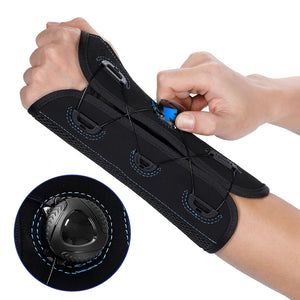How to Wear a Back Support Brace?

Just imagine carrying a heavy backpack on a long trek up a rugged mountain road, or being sitting still at your workstation for a long time, your back is like an overworked “little motor” that could go on strike at any time. Today, Fivali will unveil the mystery of back brace, teach you how to wear the correct back support brace, let your spine “full blood resurrection”!
Under What Circumstances Do I Need to Wear a Back Support Brace?
There are many different types of back braces available. Braces are a common aid to provide protection and support for the lower back. Each person's situation will be different, and wearing a back brace is usually recommended in the following situations:
1. Severe Back Injuries
When there are acute injuries to the lower back, for instance sprains or strains, they are often combined with severe pain and limited mobility. Under such circumstances, back support braces play a vital role. A back brace can effectively immobilize the lower back and reduce the movement of the lumbar discs and ligaments, thus reducing pain. By applying a back brace, you can prevent secondary injuries and accelerate wound recovery. Using a back brace is like a “crutch” that provides support for the injured lower back and reduces the burden on the muscles.

2. Post Lumbar Spine Surgery
Donning a back brace after lumbar spine surgery is like applying a protective coating to the lumbar spine, which provides all-around protection for the fragile lower back. It provides a safe and stable environment for the injured area, prevents it from secondary injuries, and provides optimal conditions for the newborn bones and soft tissues to heal so that the wound can recover better. Meanwhile, the back brace fixes the posture of use, prevents excessive movement, mandatorily corrects the back and helps to establish a good habit of sitting and standing.
3. Special Occupations
Porters, couriers, construction workers and other occupations need to use the waist for work every day, repetitive bending, lifting heavy objects, sitting or standing for a long time will cause great pressure on the spine. In the long run, it is easy to cause lumbar muscle strain, lumbar disc herniation and a series of spinal problems. Back brace can effectively support the lumbar region, reduce the magnitude of spinal curvature, and minimize the risk of spinal injuries.
Back Protection Strategy: The Right Way to Open the Back Support Brace
In order to prevent and relieve pain, many people choose to wear a back brace thus solving their problem. However, there are many types of back braces available, made of different materials, and there is a lot to be said for the correct way to wear them. If they are not chosen and worn correctly, not only will they fail to protect you, but they will also be counterproductive.
The following is a step-by-step guide to wearing the different types of Fivali back braces:
Lower back support brace version:
(1) Position the bottom of the back brace just above the top of the buttocks. Let the outer detachable Velcro straps hang freely;
(2) Fasten the inner belt;
(3) Tighten the outer adjustment straps for the best sense of back support;
(4) In the end, it is possible to move your entire body to ensure that the back brace does not slide or constrict your movement. Readjust the position as you experience discomfort.

Fivali Health Tips: Fivali Back Support Belt provides a lightweight and breathable lumbar belt for the lower back. It is designed with adjustable tension, so you can easily adjust the lumbar support according to your personal needs, and it fits the human body curves more closely to give the best effect of the back brace. And the material of this belt is soft and comfortable, which can effectively relieve lumbar fatigue and discomfort and provide good support.
Full back support brace version:
(1) Cross shoulder straps through the belt loop on the back, then put your arms through the shoulder straps like wearing a vest;
(2) Wrap the waist with the waistband, then fix with the Velcro tip;
(3) Pull the two shoulder straps and adjust to your comfy tightness, then cross and fix them on the waistband;
(4) Make your posture perfect, prevent strain, and maintain spinal health.
Disclaimer: As different back braces are made of different materials and have different functions, you should read the instructions of the corresponding products carefully before wearing or using them.

Fivali Health Tips: Fivali Back Brace Posture Corrector can be seamlessly integrated into this process by providing targeted support and immobilization to the spine. Its 2-in-1 back brace designed to provide reinforced support and improve posture. In addition, adjustable and lightweight full back support ensures a comfortable fit, while the upper and lower back pain relief features help alleviate discomfort. This back brace is ideal for those with scoliosis, hunchback, hump, thoracic, or spine correction issues.
The correct wearing of an adjustable back support brace is an important facility to relieve back pain and protect the spine. The wearing of a back brace may seem simple, but it involves a lot of learning. Only if you put it on correctly and use it wisely can you get the most out of it. If you have suffered from back pain for a long time, it is recommended that you consult a doctor in time and buy and use a best back support brace under the doctor's guidance to avoid delaying your condition.
-
Posted in
Back pain causes, Back pain solutions, Brace, Joint, Pain, Recovery













